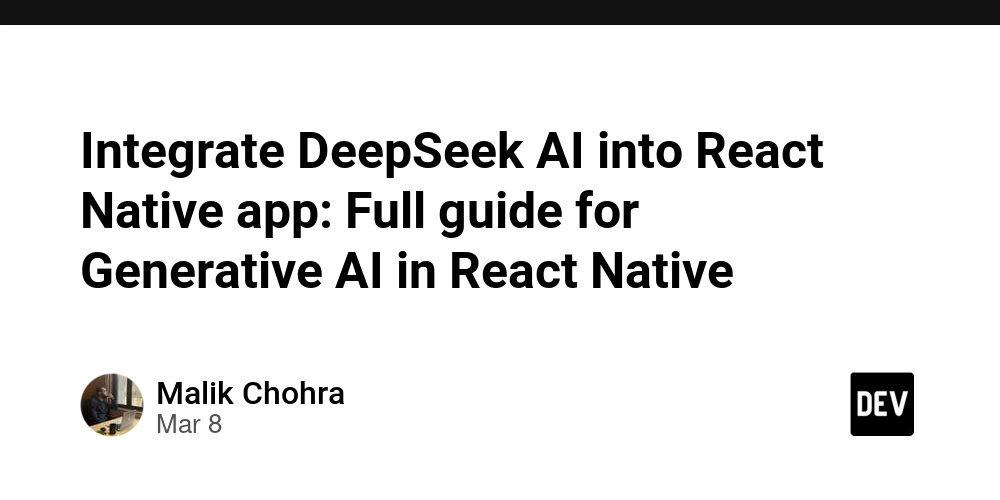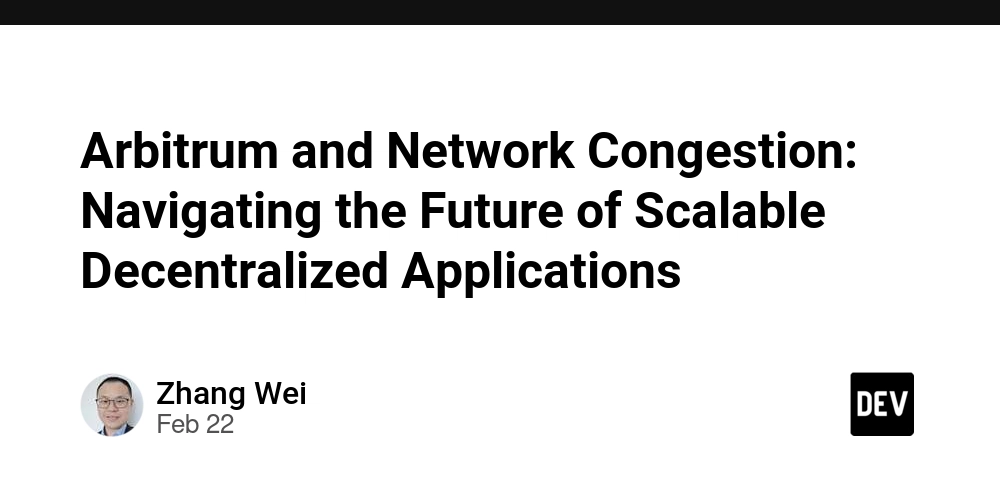Integrate DeepSeek AI into React Native app: Full guide for Generative AI in React Native
Integrate DeepSeek AI into React Native appIntegrate DeepSeek AI into React Native app: Full guide for Generative AI in React Native Introduction React Native has revolutionized mobile app development by enabling developers to build native applications using JavaScript and React. Since its introduction by Facebook (now Meta) in 2015, it has become one of the most popular frameworks for cross-platform mobile development, powering thousands of apps across iOS and Android platforms. We've witnessed an unprecedented race in generative AI development in the last year. While OpenAI's GPT series and Anthropic's Claude have dominated headlines, open-source alternatives like Meta's Llama and DeepSeek are rapidly gaining traction. These open-source models are particularly interesting because they offer comparable performance while providing more flexibility and control over deployment. Companies are racing to create an AGI that can solve all the humans problems, although the road is still far for that in my opinion, but we are getting closer each time, and billions of dollars are spent on that. For example the 500 billions projects in USA and the 50 billions AI investment from UAE in France. DeepSeek, in particular, has shown impressive results in recent benchmarks. According to their technical report, DeepSeek has demonstrated superior performance in coding tasks and mathematical reasoning compared to other open-source models. Their 67B parameter model has achieved competitive results against GPT-4 in several benchmarks, making it an attractive option for developers looking for powerful AI capabilities in their applications. DeepSeek's impressive performance in benchmarks suggests a promising future for open-source AI models. As these models continue to improve, developers will have more options for implementing AI capabilities in their applications without being locked into proprietary solutions. The ability to self-host these models or use them through APIs provides flexibility in deployment options, which is particularly important for applications with specific privacy or regulatory requirements. In this article, I will explain to you how to use it inside a React and React Native app, although the funny part is that they use Open ai SDK package to integrate their solution, which is a clever move from the company to make the switch easy, as the price/performance quote is much better if you use Deepseek that using Open AI models Integrating DeepSeek AI in React Native Let's walk through the process of integrating DeepSeek AI into a React Native application to create an AI chat interface. 1. Setting Up the Project First, ensure you have the necessary dependencies installed: context npm install react-native-gifted-chat axios react-native-paper react-native-safe-area-context // or if you are using Yarn yarn install react-native-gifted-chat axios react-native-paper react-native-safe-area-context 2. Creating the Chat Interface The implementation uses react-native-gifted-chat, a popular library for building chat interfaces in React Native. Here's how to structure your component: import React, {useState, useCallback, useEffect} from 'react'; import {GiftedChat, IMessage} from 'react-native-gifted-chat'; import axios from 'axios'; 3. Configuration Set up your DeepSeek API credentials: const DEEPSEEK_API_URL = 'https://api.deepseek.com/v1/chat/completions'; const DEEPSEEK_API_KEY = 'Your_API_Key_Here'; 4. Implementing the Chat Logic The core functionality revolves around two main parts: Message Management const [messages, setMessages] = useState([]); const [loading, setIsLoading] = useState(false); // Initialize with a welcome message useEffect(() => { setMessages([ { _id: 0, text: 'Type your question or share what's on your mind…', createdAt: new Date(), user: { _id: 0, name: 'DeepSeek', // url for deepseek logo avatar: 'https://cdn.deepseek.com/platform/favicon.png', }, }, ]); }, []); 6. API Integration const sendMessageToDeepSeek = async (userMessage: IMessage) => { setIsLoading(true); try { const response = await axios.post( DEEPSEEK_API_URL, { model: 'deepseek-chat', messages: [{role: 'user', content: userMessage}], }, { headers: { Authorization: `Bearer ${DEEPSEEK_API_KEY}`, 'Content-Type': 'application/json', }, }, ); // Process response and update chat } catch (error) { console.error('DeepSeek API Error:', error); } finally { setIsLoading(false); } 7. UI Customization const renderInputToolbar = (props: InputToolbarProps) => ( ); const renderSend = (props: SendProps) => ( ); return ( onSend(messages)} onInputTextChanged={setText} bottomOffset={insets.bottom} renderSend={renderSend} renderInputToolbar={renderIn

Integrate DeepSeek AI into React Native appIntegrate DeepSeek AI into React Native app: Full guide for Generative AI in React Native
Introduction
React Native has revolutionized mobile app development by enabling developers to build native applications using JavaScript and React. Since its introduction by Facebook (now Meta) in 2015, it has become one of the most popular frameworks for cross-platform mobile development, powering thousands of apps across iOS and Android platforms.
We've witnessed an unprecedented race in generative AI development in the last year. While OpenAI's GPT series and Anthropic's Claude have dominated headlines, open-source alternatives like Meta's Llama and DeepSeek are rapidly gaining traction. These open-source models are particularly interesting because they offer comparable performance while providing more flexibility and control over deployment.
Companies are racing to create an AGI that can solve all the humans problems, although the road is still far for that in my opinion, but we are getting closer each time, and billions of dollars are spent on that. For example the 500 billions projects in USA and the 50 billions AI investment from UAE in France.
DeepSeek, in particular, has shown impressive results in recent benchmarks. According to their technical report, DeepSeek has demonstrated superior performance in coding tasks and mathematical reasoning compared to other open-source models. Their 67B parameter model has achieved competitive results against GPT-4 in several benchmarks, making it an attractive option for developers looking for powerful AI capabilities in their applications.
DeepSeek's impressive performance in benchmarks suggests a promising future for open-source AI models. As these models continue to improve, developers will have more options for implementing AI capabilities in their applications without being locked into proprietary solutions.
The ability to self-host these models or use them through APIs provides flexibility in deployment options, which is particularly important for applications with specific privacy or regulatory requirements.
In this article, I will explain to you how to use it inside a React and React Native app, although the funny part is that they use Open ai SDK package to integrate their solution, which is a clever move from the company to make the switch easy, as the price/performance quote is much better if you use Deepseek that using Open AI models
Integrating DeepSeek AI in React Native
Let's walk through the process of integrating DeepSeek AI into a React Native application to create an AI chat interface.
1. Setting Up the Project
First, ensure you have the necessary dependencies installed:
context
npm install react-native-gifted-chat axios react-native-paper react-native-safe-area-context
// or if you are using Yarn
yarn install react-native-gifted-chat axios react-native-paper react-native-safe-area-context
2. Creating the Chat Interface
The implementation uses react-native-gifted-chat, a popular library for building chat interfaces in React Native. Here's how to structure your component:
import React, {useState, useCallback, useEffect} from 'react';
import {GiftedChat, IMessage} from 'react-native-gifted-chat';
import axios from 'axios';
3. Configuration
Set up your DeepSeek API credentials:
const DEEPSEEK_API_URL = 'https://api.deepseek.com/v1/chat/completions';
const DEEPSEEK_API_KEY = 'Your_API_Key_Here';
4. Implementing the Chat Logic
The core functionality revolves around two main parts:
Message Management
const [messages, setMessages] = useState([]);
const [loading, setIsLoading] = useState(false);
// Initialize with a welcome message
useEffect(() => {
setMessages([
{
_id: 0,
text: 'Type your question or share what's on your mind…',
createdAt: new Date(),
user: {
_id: 0,
name: 'DeepSeek',
// url for deepseek logo
avatar: 'https://cdn.deepseek.com/platform/favicon.png',
},
},
]);
}, []);
6. API Integration
const sendMessageToDeepSeek = async (userMessage: IMessage) => {
setIsLoading(true);
try {
const response = await axios.post(
DEEPSEEK_API_URL,
{
model: 'deepseek-chat',
messages: [{role: 'user', content: userMessage}],
},
{
headers: {
Authorization: `Bearer ${DEEPSEEK_API_KEY}`,
'Content-Type': 'application/json',
},
},
);
// Process response and update chat
} catch (error) {
console.error('DeepSeek API Error:', error);
} finally {
setIsLoading(false);
}
7. UI Customization
const renderInputToolbar = (props: InputToolbarProps) => (
) => (
);
return (
onSend(messages)}
onInputTextChanged={setText}
bottomOffset={insets.bottom}
renderSend={renderSend}
renderInputToolbar={renderInputToolbar}
renderChatFooter={renderFooter}
scrollToBottomComponent={renderScrollToBottom}
user={{
_id: '1',
name: 'Malik',
avatar: PROFILE_IMAGE,
}}
/>
)
The interface can be customized using custom renderers:
Check the full projects and code here: https://reactnativetemplates.com/screensCode/19
React Native Template
React Native Template, contains beaultifully designed, expert crafted React Native components and screens. To Help you…r
https://reactnativetemplates.com/ react native links
Best Practices and Considerations
API Key Security: Never expose your API key in the client-side code. Use environment variables or a backend service to secure your credentials.
Error Handling: Implement robust error handling for API calls and network issues.
Loading States: Provide visual feedback during API calls using loading indicators.
Message Persistence: Consider implementing local storage to persist chat history.
Conclusion
Integrating DeepSeek AI into a React Native application is straightforward and opens up possibilities for creating sophisticated AI-powered chat interfaces. As the AI landscape continues to evolve, having knowledge of implementing these integrations becomes increasingly valuable for modern mobile developers.
- -
This article provides a comprehensive overview of integrating DeepSeek AI with React Native, from the technical implementation details to the broader industry context. You may want to add specific benchmark numbers and more recent comparisons as they become available, as well as any additional implementation details specific to your use case.
Get the Best React Native Templates in 2025: Community work
Jumpstart your app development with high-quality React Native templates! Discover a variety of pre-designed screens and code examples at React Native Templates:
https://reactnativetemplates.com/.
Want to contribute and showcase your React Native expertise? You can easily add your own templates to share with the community and gain valuable exposure. Browse our diverse collection of React Native screens to find the ideal foundation for your next project.
If you need to integrate Advanced functionalities in your Mobile app, create one from scratch, or need consulting in react native. Visit the casainnov.com, and check their mobile app page, and contact them there.
I share insights about React Native, React, and Typescript. Follow me on Linkedin or Medium.










































































































































































![[The AI Show Episode 142]: ChatGPT’s New Image Generator, Studio Ghibli Craze and Backlash, Gemini 2.5, OpenAI Academy, 4o Updates, Vibe Marketing & xAI Acquires X](https://www.marketingaiinstitute.com/hubfs/ep%20142%20cover.png)



























































































































![[FREE EBOOKS] The Kubernetes Bible, The Ultimate Linux Shell Scripting Guide & Four More Best Selling Titles](https://www.javacodegeeks.com/wp-content/uploads/2012/12/jcg-logo.jpg)



![From drop-out to software architect with Jason Lengstorf [Podcast #167]](https://cdn.hashnode.com/res/hashnode/image/upload/v1743796461357/f3d19cd7-e6f5-4d7c-8bfc-eb974bc8da68.png?#)






































































































.png?#)




.jpg?#)































_Christophe_Coat_Alamy.jpg?#)








































































































![Rapidus in Talks With Apple as It Accelerates Toward 2nm Chip Production [Report]](https://www.iclarified.com/images/news/96937/96937/96937-640.jpg)









































































































































